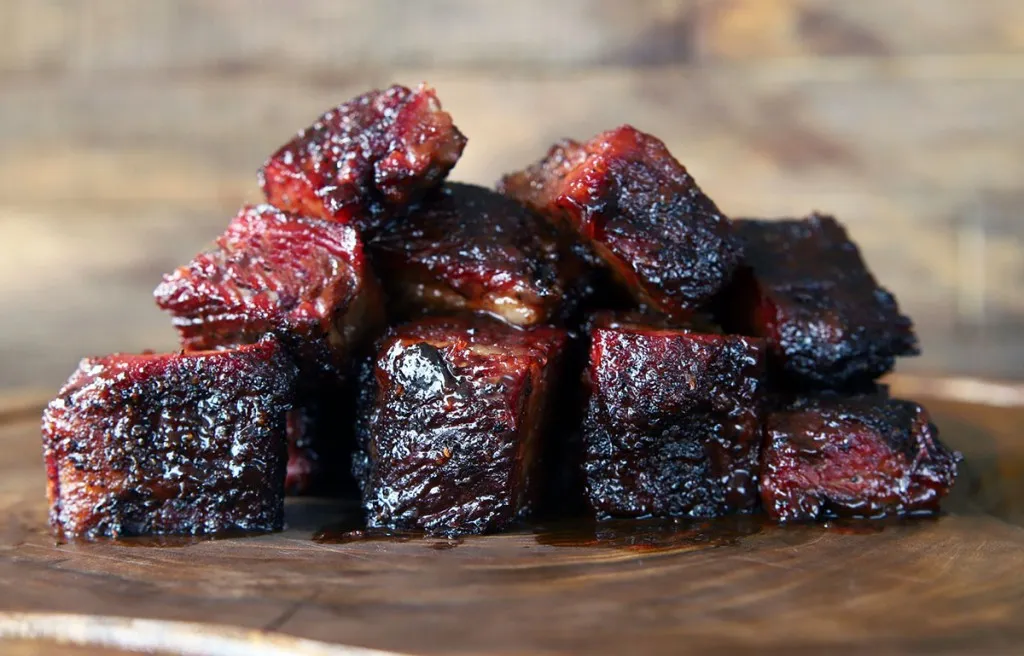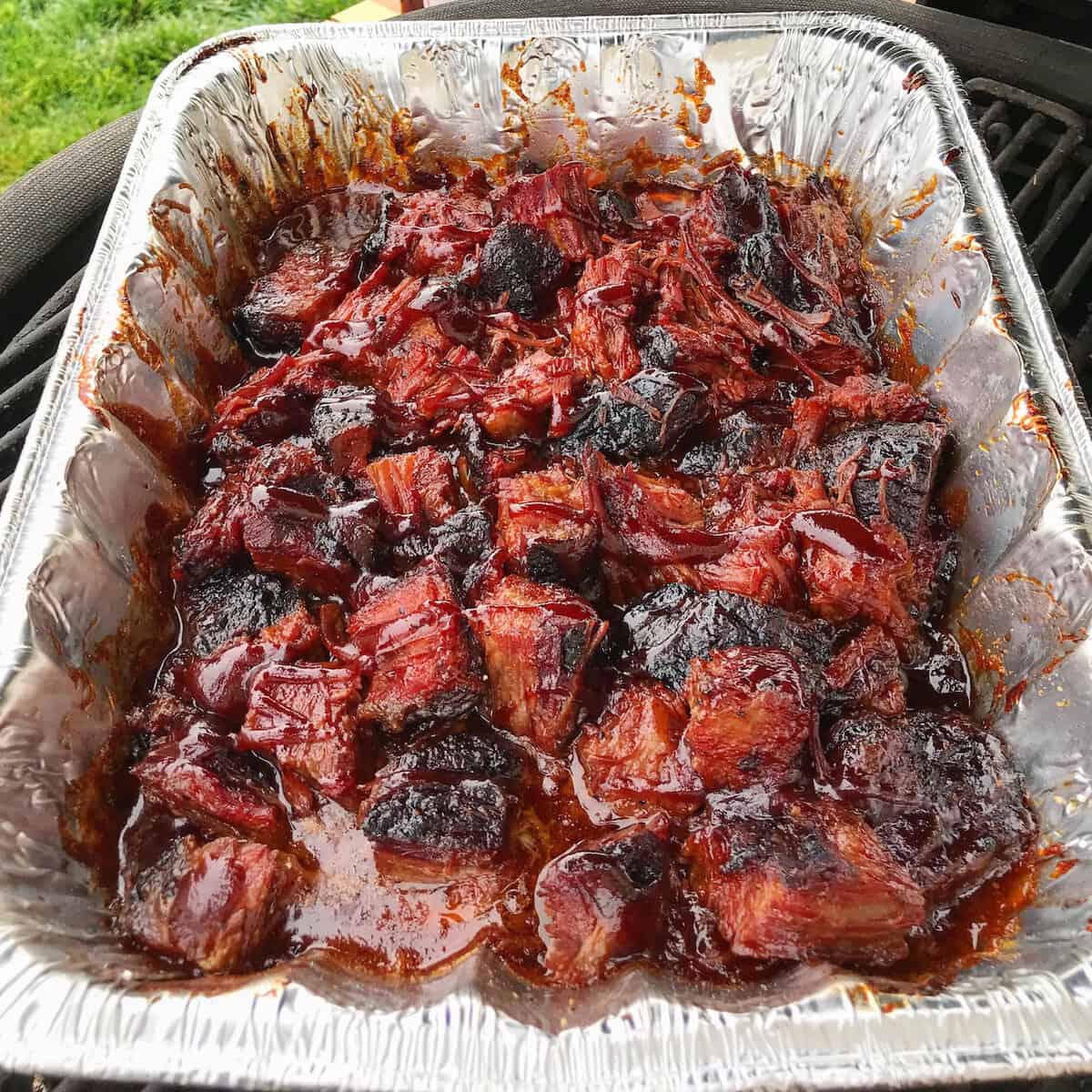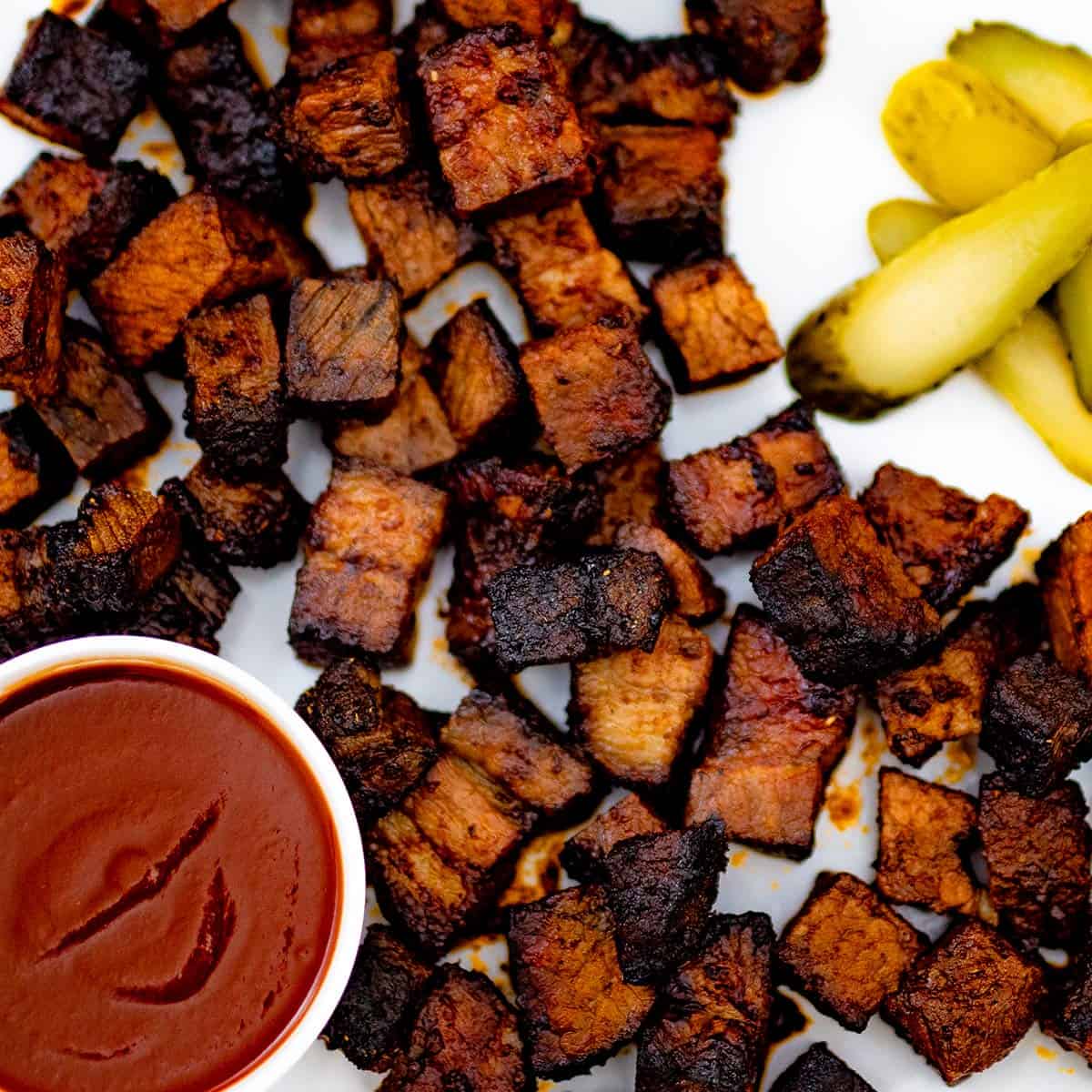To make burnt ends without a smoker, season and bake a brisket in the oven at 275°F until tender, then cut it into cubes, coat with BBQ sauce, and return to the oven at 350°F until caramelized and crispy.
Smokerless BBQ: How to Make Tender and Juicy Burnt Ends in Your Oven
Smokerless BBQ, also known as oven BBQ, is a method of cooking barbecue without the use of a traditional smoker. This technique allows you to achieve the same smoky flavors and tender textures of traditional BBQ, but without the need for specialized equipment. Smokerless BBQ is a great option for those who don’t have access to a smoker or simply prefer to cook indoors.
One of the main benefits of smokerless BBQ is its convenience. Unlike traditional smoking methods that require hours of tending to a fire, smokerless BBQ can be done in the comfort of your own kitchen. This makes it a great option for those who live in apartments or areas where outdoor grilling is not allowed. Additionally, smokerless BBQ allows you to cook barbecue year-round, regardless of the weather conditions outside.
What are burnt ends and why are they so popular?
Burnt ends are a popular barbecue dish that originated in Kansas City, Missouri. They are made from the fatty ends of a beef brisket, which are cooked low and slow until they become tender and caramelized. The result is a flavorful and succulent piece of meat that is crispy on the outside and melt-in-your-mouth tender on the inside.
The popularity of burnt ends can be attributed to their unique texture and flavor profile. The slow cooking process allows the fat to render down, creating a rich and smoky flavor. The crispy exterior provides a satisfying crunch, while the tender interior is packed with juicy goodness. Burnt ends are often served with barbecue sauce or glaze, which adds another layer of flavor and enhances their overall appeal.
Choosing the right cut of meat for burnt ends
When it comes to making burnt ends, choosing the right cut of meat is crucial. While beef brisket is the most common choice for burnt ends, other cuts such as pork belly or pork shoulder can also be used. The key is to select a cut of meat that has a good amount of fat marbling, as this will contribute to the tenderness and flavor of the final dish.
For beef burnt ends, the point cut of a brisket is preferred over the flat cut. The point cut has more fat marbling, which will render down during the cooking process and create a rich and flavorful end result. When choosing a pork cut for burnt ends, pork belly is a popular choice due to its high fat content. Pork shoulder can also be used, but it may require a longer cooking time to achieve the desired tenderness.
Factors to consider when choosing meat for burnt ends include the size of the cut, the quality of the meat, and personal preference. It’s important to select a cut that is large enough to yield a sufficient amount of burnt ends, but not so large that it becomes difficult to handle or cook evenly. Additionally, choosing high-quality meat from a reputable source will ensure that you end up with the best possible results.
Preparing the meat for cooking
Before cooking the meat for burnt ends, it’s important to properly trim and cut it to ensure even cooking and optimal flavor. Trimming involves removing any excess fat or silver skin from the surface of the meat. This not only improves the appearance of the final dish but also allows the seasoning and smoke to penetrate the meat more effectively.
To trim the meat, use a sharp knife to carefully remove any thick layers of fat or silver skin. Be sure to leave a thin layer of fat on top of the meat to help keep it moist during cooking. Once trimmed, you can proceed to cut the meat into cubes or chunks, depending on your preference. Aim for uniform pieces that are roughly 1-2 inches in size for even cooking.
After trimming and cutting the meat, it’s important to prepare it for seasoning. This involves applying a dry rub or marinade to enhance the flavor of the meat. The seasoning can be as simple as salt and pepper, or you can get creative and use a combination of herbs, spices, and other flavorings. Allow the meat to marinate for at least 1-2 hours, or overnight if time allows, to allow the flavors to penetrate the meat.
Creating a flavorful dry rub
A good dry rub is essential for adding flavor to your burnt ends. It helps to enhance the natural flavors of the meat and creates a delicious crust on the outside. While there are many pre-made dry rubs available on the market, making your own allows you to customize the flavors to your liking.
A basic dry rub typically consists of a combination of salt, sugar, and spices. The salt helps to season the meat, while the sugar adds a touch of sweetness and helps with caramelization. The spices can vary depending on your personal preference, but common choices include paprika, chili powder, garlic powder, onion powder, and black pepper.
To create a flavorful dry rub, start by combining 2 tablespoons of salt, 2 tablespoons of sugar, and 1 tablespoon each of paprika, chili powder, garlic powder, onion powder, and black pepper in a bowl. Mix well to ensure that all the ingredients are evenly distributed. You can adjust the quantities of each ingredient to suit your taste preferences.
Cooking the meat in the oven
Once the meat has been trimmed, cut, and seasoned, it’s time to cook it in the oven. While it may not provide the same smoky flavor as a traditional smoker, there are techniques you can use to achieve a similar result.
To cook the meat in the oven, preheat it to 275°F (135°C). Place the seasoned meat on a wire rack set inside a baking sheet or roasting pan. This allows air to circulate around the meat, ensuring even cooking and preventing it from sitting in its own juices.
Cook the meat for approximately 3-4 hours, or until it reaches an internal temperature of 195°F (90°C). This low and slow cooking method allows the fat to render down and the collagen to break down, resulting in tender and flavorful burnt ends. To achieve a smoky flavor, you can add wood chips or chunks to a foil packet and place it in the oven. The wood will release smoke as it heats up, infusing the meat with a smoky aroma.
Adding moisture to prevent dryness
One of the challenges of cooking meat in the oven is preventing it from drying out. To ensure that your burnt ends are moist and tender, it’s important to add moisture during the cooking process.
There are several techniques you can use to add moisture to the meat. One option is to place a pan of water or broth in the oven alongside the meat. As the liquid evaporates, it creates steam that helps to keep the meat moist. Another option is to baste the meat with a liquid such as barbecue sauce or apple juice every hour or so. This not only adds moisture but also enhances the flavor of the meat.
Additionally, you can wrap the meat in foil or butcher paper during the cooking process. This helps to trap moisture and create a more humid environment, resulting in juicier burnt ends. However, be aware that wrapping the meat may prevent it from developing a crispy exterior, so it’s important to find a balance between moisture and texture.
Monitoring the internal temperature of the meat
Monitoring the internal temperature of the meat is crucial for achieving perfectly cooked burnt ends. This allows you to determine when the meat is done and ensures that it reaches the desired level of tenderness.
To monitor the internal temperature, use a digital meat thermometer with a probe that can be inserted into the thickest part of the meat. Insert the probe into the meat, being careful not to touch any bones or the wire rack. Close the oven door and allow the meat to cook until it reaches an internal temperature of 195°F (90°C).
It’s important to note that the cooking time may vary depending on the size and thickness of the meat, as well as the accuracy of your oven. Use the internal temperature as a guide, rather than relying solely on cooking time. If the meat is not yet done but has reached the desired internal temperature, you can continue cooking it until it reaches the desired level of tenderness.
Finishing touches: glazing and caramelization
To add a final touch of flavor and visual appeal to your burnt ends, consider glazing and caramelizing them. This step helps to create a sticky and sweet exterior that complements the smoky and savory flavors of the meat.
To glaze and caramelize your burnt ends, remove them from the oven when they reach an internal temperature of 195°F (90°C). Brush them with your favorite barbecue sauce or glaze, making sure to coat all sides evenly. Return the meat to the oven and increase the temperature to 400°F (200°C). Cook for an additional 10-15 minutes, or until the glaze has thickened and caramelized.
Keep a close eye on the meat during this step to prevent it from burning. The high heat can cause the sugars in the glaze to burn quickly, so it’s important to monitor it closely. If necessary, you can move the meat to a lower rack or reduce the oven temperature slightly to prevent burning.
Serving and enjoying your delicious burnt ends
Once your burnt ends are cooked to perfection, it’s time to serve and enjoy them. There are several tips you can follow to ensure that they are presented and enjoyed at their best.
When serving burnt ends, it’s important to slice them into bite-sized pieces for easy eating. Use a sharp knife to cut the meat into cubes or chunks, making sure to slice against the grain for maximum tenderness. Arrange the burnt ends on a platter or serving dish, and garnish with fresh herbs or a sprinkle of your favorite dry rub for added flavor and visual appeal.
Burnt ends are often served with barbecue sauce or glaze on the side for dipping or drizzling. Consider offering a variety of sauces to cater to different taste preferences. Classic choices include Kansas City-style barbecue sauce, Carolina-style vinegar-based sauce, or a tangy mustard-based sauce.
When it comes to side dishes, there are many options that pair well with burnt ends. Traditional choices include coleslaw, baked beans, cornbread, and potato salad. These dishes provide a refreshing contrast to the rich and smoky flavors of the meat. For drinks, consider serving ice-cold beer, lemonade, or sweet tea to complement the barbecue flavors.
Tips for experimenting with different flavors and techniques
While the traditional method of making burnt ends is delicious on its own, there are endless possibilities for experimenting with different flavors and techniques. This allows you to put your own spin on this classic barbecue dish and create something truly unique.
One way to experiment with flavors is by using different types of wood chips or chunks to add a smoky aroma to the meat. Popular choices include hickory, mesquite, applewood, and cherry wood. Each type of wood imparts its own distinct flavor profile, so feel free to mix and match to find your favorite combination.
Another way to experiment is by trying different dry rubs or marinades. You can vary the spices and seasonings used in the rub to create different flavor profiles. For example, you could try adding cumin and coriander for a Mexican-inspired twist, or ginger and soy sauce for an Asian-inspired flavor.
Additionally, you can experiment with different cooking techniques to achieve different textures and flavors. For example, you could try smoking the meat on a charcoal grill or using a sous vide machine to cook it at a precise temperature. These techniques may require some additional equipment and preparation, but they can yield delicious results.
In conclusion, smokerless BBQ is a convenient and delicious way to enjoy the flavors of barbecue without the need for a traditional smoker. Burnt ends, a popular barbecue dish made from the fatty ends of a brisket, are a great option for those looking to try their hand at smokerless BBQ. By choosing the right cut of meat, preparing it properly, and using the right techniques and flavors, you can create mouthwatering burnt ends that rival those made in a traditional smoker. So fire up your oven, gather your ingredients, and get ready to enjoy some delicious smokerless BBQ!
Originally posted 2024-02-07 01:39:56.



